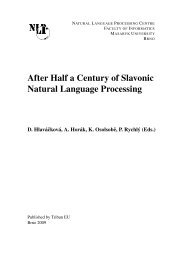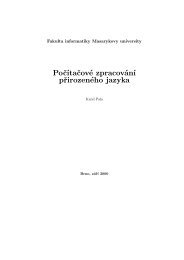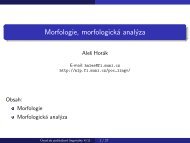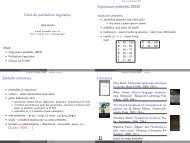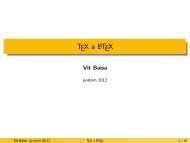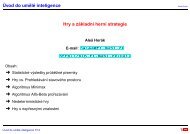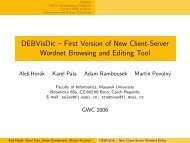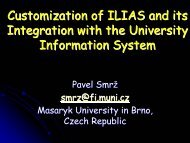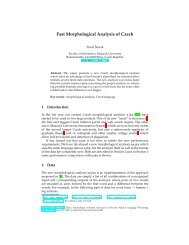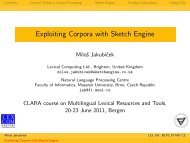GATE: A Unicode-based Infrastructure for Multilingual Information ...
GATE: A Unicode-based Infrastructure for Multilingual Information ...
GATE: A Unicode-based Infrastructure for Multilingual Information ...
Create successful ePaper yourself
Turn your PDF publications into a flip-book with our unique Google optimized e-Paper software.
<strong>GATE</strong>: A <strong>Unicode</strong>-<strong>based</strong> <strong>Infrastructure</strong> Supporting <strong>Multilingual</strong><br />
In<strong>for</strong>mation Extraction<br />
Kalina Bontcheva and Diana Maynard and Valentin Tablan and<br />
Hamish Cunningham<br />
Dept. of Computer Science, University of Sheffield<br />
Regent Court, 211 Portobello St, Sheffield, S1 4DP, UK<br />
[K.Bontcheva, D.Maynard, V.Tablan, H.Cunningham]@dcs.shef.ac.uk<br />
Abstract<br />
NLP infrastructures with comprehensive multilingual<br />
support can substantially decrease the<br />
overhead of developing In<strong>for</strong>mation Extraction<br />
(IE) systems in new languages by offering support<br />
<strong>for</strong> different character encodings, languageindependent<br />
components, and clean separation<br />
between linguistic data and the algorithms<br />
that use it. This paper will present <strong>GATE</strong><br />
– a <strong>Unicode</strong>-aware infrastructure that offers<br />
extensive support <strong>for</strong> multilingual In<strong>for</strong>mation<br />
Extraction with a special emphasis on lowoverhead<br />
portability between languages. <strong>GATE</strong><br />
has been used in many research and commercial<br />
projects at Sheffield and elsewhere, including<br />
In<strong>for</strong>mation Extraction in Bulgarian, Romanian,<br />
Russian, and many other languages.<br />
1 Introduction<br />
<strong>GATE</strong>(Cunningham 02) 1 is an architecture, development<br />
environment and framework <strong>for</strong> building<br />
systems that process human language. It<br />
has been in development at the University of<br />
Sheffield since 1995, and has been used <strong>for</strong> many<br />
R&D projects, including In<strong>for</strong>mation Extraction<br />
in multiple languages and <strong>for</strong> multiple tasks and<br />
clients.<br />
The <strong>GATE</strong> architecture defines almost everything<br />
in terms of components - reusable units of<br />
code that are specialised <strong>for</strong> a specific task. There<br />
are three main types of components:<br />
• Language Resources (LRs) store some kind of<br />
linguistic data such as documents, corpora,<br />
ontologies and provide services <strong>for</strong> accessing<br />
it. At the moment all the predefined LRs are<br />
text <strong>based</strong> but the model doesn’t constrict<br />
the data <strong>for</strong>mat so the framework could be<br />
extended to handle multimedia documents as<br />
well.<br />
• Processing Resources (PRs) are resources<br />
whose character is principally programatic or<br />
1 <strong>GATE</strong> is implemented in Java and is freely available<br />
from http://gate.ac.uk as open-source free software under<br />
the GNU library licence.<br />
algorithmic such as a POS tagger or a parser.<br />
In most cases PRs are used to process the<br />
data provided by one or more LRs but that<br />
is not a requirement.<br />
• Visual Resources (VRs) are graphical components<br />
that are displayed by the user interface<br />
and allow the visualisation and editing<br />
of other types of resources or the control of<br />
the execution flow.<br />
The <strong>GATE</strong> framework defines some basic language<br />
resources such as documents and corpora,<br />
provides resource discovery and loading facilities<br />
and supports various kinds of input output operations<br />
such as <strong>for</strong>mat decoding, file or database<br />
persistence.<br />
<strong>GATE</strong> uses a single unified model of annotation<br />
- a modified <strong>for</strong>m of the TIPSTER <strong>for</strong>mat (Grishman<br />
97) which has been made largely compatible<br />
with the Atlas <strong>for</strong>mat (Bird & Liberman 99), and<br />
uses the now standard mechanism of ‘stand-off<br />
markup’ (Thompson & McKelvie 97). Annotations<br />
are characterised by a type and a set of features<br />
represented as attribute-value pairs. The<br />
annotations are stored in structures called annotation<br />
sets which constitute independent layers of<br />
annotation over the text content.<br />
The advantage of converting all <strong>for</strong>matting in<strong>for</strong>mation<br />
and corpus markup into a unified representation,<br />
i.e. the annotations, is that NLP applications<br />
do not need to be adapted <strong>for</strong> the different<br />
<strong>for</strong>mats of each of the documents, which<br />
are catered <strong>for</strong> by the <strong>GATE</strong> <strong>for</strong>mat filters (e.g.<br />
some corpora such as BNC come as SGML/XML<br />
files, while others come as email folders, HTML<br />
pages, news wires, or Word documents).<br />
The work <strong>for</strong> the second version of <strong>GATE</strong><br />
started in 1999 and led to a complete redesign of<br />
the system and a 100% Java implementation. One<br />
of the additions brought by version 2 is full support<br />
<strong>for</strong> <strong>Unicode</strong> data allowing the users to open,<br />
visualise and process documents in languages dif-
ferent from the default one <strong>for</strong> the underlying<br />
plat<strong>for</strong>m.<br />
2 In<strong>for</strong>mation Extraction in <strong>GATE</strong><br />
Provided with <strong>GATE</strong> is a set of reusable processing<br />
resources <strong>for</strong> common NLP tasks. (None<br />
of them are definitive, and the user can replace<br />
and/or extend them as necessary.) These are<br />
packaged together to <strong>for</strong>m ANNIE, A Nearly-New<br />
IE system, but can also be used individually or<br />
coupled together with new modules in order to<br />
create new applications. For example, many other<br />
NLP tasks might require a sentence splitter and<br />
POS tagger, but would not necessarily require resources<br />
more specific to IE tasks such as a named<br />
entity transducer. The system is in use <strong>for</strong> a variety<br />
of IE and other tasks, sometimes in combination<br />
with other sets of application-specific modules.<br />
ANNIE consists of the following main processing<br />
resources: tokeniser, sentence splitter, POS<br />
tagger, gazetteer, finite state transducer (<strong>based</strong><br />
on <strong>GATE</strong>’s built-in regular expressions over annotations<br />
language (Cunningham et al. 02b)),<br />
and orthomatcher. The resources communicate<br />
via <strong>GATE</strong>’s annotation API, which is a directed<br />
graph of arcs bearing arbitrary feature/value<br />
data, and nodes rooting this data into document<br />
content (in this case text).<br />
The tokeniser splits text into simple tokens,<br />
such as numbers, punctuation, symbols, and<br />
words of different types (e.g. with an initial capital,<br />
all upper case, etc.). The aim is to limit the<br />
work of the tokeniser to maximise efficiency, and<br />
enable greater flexibility by placing the burden of<br />
analysis on the grammars. This means that the<br />
tokeniser does not need to be modified <strong>for</strong> different<br />
applications or text types and frequently does<br />
not need to be modified <strong>for</strong> new languages, i.e.,<br />
tends to be fairly language-independent.<br />
The sentence splitter is a cascade of finitestate<br />
transducers which segments the text into<br />
sentences. This module is required <strong>for</strong> the tagger.<br />
Both the splitter and tagger are domain- and<br />
application-independent.<br />
The POS tagger is a modified version of<br />
the Brill tagger, which produces a part-of-speech<br />
(POS) tag as an annotation on each word or symbol.<br />
Neither the splitter nor the tagger are a<br />
mandatory part of the NE system, but the annotations<br />
they produce can be used by the grammar<br />
(described below), in order to increase its power<br />
and coverage. For languages where no POS tagger<br />
is available it can be left out, often without<br />
major implications on the system’s per<strong>for</strong>mance<br />
on some IE tasks. Alternatively, the English POS<br />
tagger can easily be adapted to a new language<br />
using a bi-lingual lexicon (see Section 4.3).<br />
The gazetteer consists of lists such as cities,<br />
organisations, days of the week, etc. It not only<br />
consists of entities, but also of names of useful<br />
indicators, such as typical company designators<br />
(e.g. ‘Ltd.’), titles, etc. The gazetteer lists are<br />
compiled into finite state machines, which can<br />
match text tokens.<br />
The semantic tagger consists of hand-crafted<br />
rules written in the JAPE (Java Annotations Pattern<br />
Engine) language (Cunningham et al. 02b),<br />
which describe patterns to match and annotations<br />
to be created as a result. JAPE is a version<br />
of CPSL (Common Pattern Specification Language)<br />
(Appelt 96), which provides finite state<br />
transduction over annotations <strong>based</strong> on regular<br />
expressions. A JAPE grammar consists of a<br />
set of phases, each of which consists of a set of<br />
pattern/action rules, and which run sequentially.<br />
Patterns can be specified by describing a specific<br />
text string, or annotations previously created by<br />
modules such as the tokeniser, gazetteer, or document<br />
<strong>for</strong>mat analysis. Rule prioritisation (if activated)<br />
prevents multiple assignment of annotations<br />
to the same text string.<br />
The orthomatcher is another optional module<br />
<strong>for</strong> the IE system. Its primary objective is to<br />
per<strong>for</strong>m co-reference, or entity tracking, by recognising<br />
relations between entities. It also has a<br />
secondary role in improving named entity recognition<br />
by assigning annotations to previously unclassified<br />
names, <strong>based</strong> on relations with existing<br />
entities.<br />
3 Support <strong>for</strong> <strong>Multilingual</strong><br />
Documents and Corpora in <strong>GATE</strong><br />
The most important types of Language Resources<br />
that are predefined in <strong>GATE</strong> are documents and<br />
corpora. A corpus is defined in <strong>GATE</strong> as a list of<br />
documents.<br />
Documents in <strong>GATE</strong> are typically created<br />
starting from an external resource such as a file<br />
situated either on a local disk or at an arbitrary<br />
location on the Internet. Text needs to be converted<br />
to and from binary data, using an encod-
Figure 1: The GUK <strong>Unicode</strong> editor using a Korean<br />
virtual keyboard.<br />
ing (or charset), in order to be saved into or read<br />
from a file. There are many different encodings<br />
used worldwide, some of them designed <strong>for</strong> a particular<br />
language, others covering the entire range<br />
of characters defined by <strong>Unicode</strong>. <strong>GATE</strong> uses the<br />
facilities provided by Java and so it has access to<br />
over 100 different encodings including the most<br />
popular local ones, such as ISO 8859-1 in Western<br />
countries or ISO-8859-9 in Eastern Europe,<br />
and some <strong>Unicode</strong> ones e.g. UTF-8 or UTF-16.<br />
Once processed, the documents can also be saved<br />
back to their original <strong>for</strong>mat and encoding.<br />
Apart from being able to read several character<br />
encodings, <strong>GATE</strong> supports a range of popular file<br />
<strong>for</strong>mats such as HTML, XML, email, some types<br />
of SGML and RTF.<br />
Another important aspect is displaying and<br />
editing multilingual documents. <strong>GATE</strong> uses<br />
largely the Java <strong>Unicode</strong> support <strong>for</strong> displaying<br />
multilingual documents. Editing multilingual<br />
documents (and also language-specific grammars,<br />
gazetteer lists, etc) is provided by GUK – <strong>GATE</strong>’s<br />
<strong>Unicode</strong> Kit. GUK provides input methods <strong>for</strong> a<br />
large number of languages (see Figure 1), allows<br />
the definition of new ones, and also provides a<br />
<strong>Unicode</strong>-<strong>based</strong> text editor.<br />
So far <strong>GATE</strong> has been used successfully to<br />
create corpora and process documents in a wide<br />
range of languages – Slavic (e.g., Bulgarian, Russian),<br />
Germanic (Maynard et al. 01; Gambäck &<br />
Olsson 00), Romance (e.g., Romanian) (Pastra et<br />
al. 02), Asian (e.g., Hindi, Bengali) (McEnery et<br />
al. 00), Chinese, Arabic, and Cebuano (Maynard<br />
et al. 03).<br />
4 Adapting the <strong>GATE</strong> Components<br />
to Multiple Languages<br />
The use of the Java plat<strong>for</strong>m implies that all<br />
processing resources that access textual data will<br />
internally use <strong>Unicode</strong> to represent data, which<br />
means that all PRs can virtually be used <strong>for</strong> text<br />
in any <strong>Unicode</strong> supported language. Most PRs,<br />
however, need some kind of linguistic data in order<br />
to per<strong>for</strong>m their tasks (e.g. a parser will need<br />
a grammar) which in most cases is language specific.<br />
In order to make the algorithms provided<br />
with <strong>GATE</strong> (in the <strong>for</strong>m of PRs) as languageindependent<br />
as possible, and as a good design<br />
principle, there is always a clear distinction between<br />
the algorithms - presented in the <strong>for</strong>m of<br />
machine executable code - and their linguistic<br />
resources which are typically external files. All<br />
PRs use the textual data decoding mechanisms<br />
when loading the external resources so these resources<br />
can be represented in any supported encoding<br />
which allows <strong>for</strong> instance a gazetteer list<br />
to contain localised names. This design made it<br />
possible to port our in<strong>for</strong>mation extraction system<br />
ANNIE from English to other languages by<br />
simply creating the required linguistic resources.<br />
4.1 The <strong>Unicode</strong> Tokeniser<br />
One of the PRs provided with <strong>GATE</strong> is the tokeniser<br />
which not only handles <strong>Unicode</strong> data but<br />
is actually built around the <strong>Unicode</strong> standard,<br />
hence its name of “<strong>GATE</strong> <strong>Unicode</strong> Tokeniser”.<br />
Like many other <strong>GATE</strong> PRs, the tokeniser is<br />
<strong>based</strong> on a finite state machine (FSM ) which is<br />
an efficient way of processing text. In order to<br />
provide a language independent solution, the tokeniser<br />
doesn’t use the actual text characters as<br />
input symbols, but rather their categories as defined<br />
by the <strong>Unicode</strong> standard.<br />
As part of our work on multilingual IE, the ruleset<br />
of the tokeniser was improved, because originally<br />
it was intended <strong>for</strong> Indo-European languages<br />
and there<strong>for</strong>e only handled a restricted range of<br />
characters (essentially, the first 256 codes, which<br />
follow the arrangement of ISO-8859-1 (Latin1).<br />
We created a modified version of this which would<br />
deal with a wider range of <strong>Unicode</strong> characters,<br />
such as those used in Chinese, Arabic, Indic languages<br />
etc. There is some overlap between the<br />
<strong>Unicode</strong> characters used <strong>for</strong> different languages.<br />
Codes which represent letters, punctuation, symbols,<br />
and diacritics that are generally shared by
multiple languages or scripts are grouped together<br />
in several locations, and characters with common<br />
characteristics are grouped together contiguously<br />
(<strong>for</strong> example, right-to-left scripts are grouped together).<br />
Character code allocation is there<strong>for</strong>e<br />
not correlated with language-dependent collation.<br />
In order to enable the tokeniser to handle<br />
other <strong>Unicode</strong> characters, we had to find<br />
the relevant character types and their symbolic<br />
equivalents (e.g. type 5 has the symbolic<br />
equivalent “OTHER LETTER”; type 8<br />
characters are usually at the beginning or end<br />
of a word and have the symbolic equivalent<br />
“COMBINING SPACING MARK” or “NON-<br />
SPACING MARK”). Rules covering these types<br />
were added to the tokeniser in order to discover<br />
the tokens correctly in a variety of other languages.<br />
Even more importantly, having discovered<br />
the technique <strong>for</strong> extending the tokeniser in<br />
this way, it will be easy to add any further new<br />
types as necessary, depending on the language<br />
(since we have not covered all possibilities).<br />
4.2 Localising the Gazetteer Lists<br />
The <strong>GATE</strong> gazetteer processing resource enables<br />
gazetteer lists to be described in 3 ways: majorType,<br />
minorType and language. The major<br />
and minor types enable entries to be classified according<br />
to two dimensions or at 2 levels of granularity<br />
– <strong>for</strong> example a list of cities might have<br />
a majorType “location” and minorType “city”.<br />
The language classification enables the creation<br />
of parallel lists, one <strong>for</strong> each language.<br />
For example, <strong>for</strong> our Cebuano 2 IE experiment<br />
(see Section 5.4) we had the same structure <strong>for</strong> the<br />
Cebuano lists as <strong>for</strong> their English counterparts,<br />
and simply altered the language label, to differentiate<br />
between the two. This is useful <strong>for</strong> languages<br />
where names of English entities can be found in<br />
the texts in the other language (e.g. <strong>for</strong> Cebuano<br />
– “Cebu City Police Office”). To recognise<br />
these successfully we required both the English<br />
gazetteer (to recognise “Office”) and the Cebuano<br />
gazetteer (to recognise “Cebu City”, which is not<br />
in the English gazetteer). Using both gazetteers<br />
improved recall and did not appear to affect precision,<br />
since English entities did not seem to be ambiguous<br />
with Cebuano entities or proper nouns.<br />
However, this might not be the case <strong>for</strong> other,<br />
closer languages.<br />
2 A language spoken in the South Philippines.<br />
4.3 <strong>Multilingual</strong> Adaptation of the POS<br />
Tagger<br />
The Hepple POS tagger, which is freely available<br />
in <strong>GATE</strong> as part of ANNIE, is similar to<br />
the Brill’s trans<strong>for</strong>mation-<strong>based</strong> tagger (Brill 92),<br />
but differs mainly in that it uses a decision list<br />
variant of Brill’s algorithm. This means that in<br />
classifying any instance, only one trans<strong>for</strong>mation<br />
can apply. It is also written in Java.<br />
In order to adapt the POS tagger to a new language,<br />
one would typically need to re-train it on<br />
a big part-of-speech annotated corpus. However,<br />
there are no such corpora <strong>for</strong> many languages, so<br />
we experimented with adapting the POS tagger to<br />
a new language without such training data, only<br />
using a bilingual lexicon.<br />
As part of the ANNIE adaptation to Cebuano<br />
(see Section 5.4), we tested whether we could<br />
adapt the Hepple tagger to Cebuano using a bilingual<br />
Cebuano-English lexicon with POS in<strong>for</strong>mation.<br />
On first appearances it seemed that Cebuano<br />
word order and morphology is similar to<br />
English, and it also has similar orthography. The<br />
rules <strong>for</strong> English (derived from training on the<br />
Wall Street Journal) would clearly not be applicable<br />
<strong>for</strong> Cebuano, so we used an empty ruleset,<br />
but we decided that many of the default heuristics<br />
might still be appropriate. The heuristics are<br />
essentially as follows:<br />
1. look up the word in the lexicon<br />
2. if no lexicon entry found:<br />
• if capitalised return NNP<br />
• if word containes ”-” return JJ<br />
• if word contains a digit return CD<br />
• if word ends in ”ed”, ”us”, ”ic”, ”ble”,<br />
”ive”, ”ish”, ”ary”, ”ful”, ”ical”, ”less”<br />
return JJ<br />
• if word ends in ”s” return NNS<br />
• if word ends in ”ly” return RB<br />
• if word ends in ”ing” return VBG<br />
• if none of the above matched return NN<br />
3. apply the trained rules to make changes to<br />
the assigned categories <strong>based</strong> on the context<br />
Some of these heuristics make little sense <strong>for</strong> Cebuano<br />
because it is unusual <strong>for</strong> Cebuano words to<br />
have endings such as “ic”,“ly”, “ing” etc. This<br />
means that in most cases, when a word is not in
the lexicon, the tag returned will be NNP (proper<br />
noun) if capitalised, or NN (common noun) if not,<br />
which is appropriate. However, these heuristics<br />
cannot be changed without modifying the code of<br />
the POS tagger itself, there<strong>for</strong>e we left them unchanged<br />
even though most of them did not apply.<br />
Adapting the tagger did have a number of problems,<br />
mostly associated with the fact that while<br />
the English lexicon (used <strong>for</strong> the tagger) consists<br />
only of single-word entries, the Cebuano lexicon<br />
contained many multi-word entries (such as mahitungod<br />
sa honi (musical)). The tagger expects<br />
lexicon entries to have a single word entry per<br />
line, followed by one or more POS tags, each separated<br />
by a single space.<br />
We there<strong>for</strong>e modified the lexicon so that the<br />
delimiter between the lexical entry and the POS<br />
tag(s) was a “#” rather than a space, and adapted<br />
the tagging mechanism to recognise this. As a result,<br />
the ANNIE POS tagger now has the option<br />
of processing multi-word entries, which are very<br />
important in a number of languages, e.g., the AN-<br />
NIE adaptation to Hindi also required this.<br />
In order to evaluate the portability and usefulness<br />
of such low-overhead adaptation of the<br />
POS tagger, we repeated the same experiment <strong>for</strong><br />
Hindi, using a relatively small English-Hindi bilingual<br />
lexicon. The results were 67% correctness as<br />
evaluated by a native Hindi speaker. Whereas<br />
such correctness may not be sufficient <strong>for</strong> deeper<br />
linguistic processing (e.g., parsing), it is sufficient<br />
<strong>for</strong> named entity recognition.<br />
Next we discuss how these multilingual processing<br />
resources were used to per<strong>for</strong>m in<strong>for</strong>mation<br />
extraction in a variety of languages.<br />
5 In<strong>for</strong>mation Extraction in Multiple<br />
Languages<br />
Robust tools <strong>for</strong> multilingual in<strong>for</strong>mation extraction<br />
are becoming increasingly sought after now<br />
that we have capabilities <strong>for</strong> processing texts<br />
in different languages and scripts. While the<br />
ANNIE IE system in <strong>GATE</strong> is English-specific,<br />
some of the modules can be reused directly (e.g.<br />
the <strong>Unicode</strong>-<strong>based</strong> tokeniser can handle Indo-<br />
European languages), and/or easily customised<br />
<strong>for</strong> new languages (Pastra et al. 02). So far, AN-<br />
NIE has been adapted to do IE in Bulgarian, Romanian,<br />
Bengali, Greek, Spanish, Swedish, German,<br />
Italian, French, Hindi, and Cebuano, and<br />
we are currently porting it to Arabic, Chinese and<br />
Russian, as part of the MUSE project 3 .<br />
5.1 NE in Slavonic languages<br />
The Bulgarian NE recogniser (Paskaleva et al. 02)<br />
was built using three main processing resources:<br />
a tokeniser, a gazetteer and a semantic grammar<br />
built using JAPE. There was no POS tagger<br />
available in Bulgarian, and consequently we<br />
had no need of a sentence splitter either. The<br />
main changes to the system were in terms of the<br />
gazetteer lists (e.g. lists of first names, days of the<br />
week, locations etc. were tailored <strong>for</strong> Bulgarian),<br />
and in terms of some of the pattern matching rules<br />
in the grammar. For example, Bulgarian makes<br />
far more use of morphology than English does,<br />
e.g. 91% of Bulgarian surnames could be directly<br />
recognised using morphological in<strong>for</strong>mation. The<br />
lack of a POS tagger meant that many rules had<br />
to be specified in terms of orthographic features<br />
rather than parts of speech. An example Bulgarian<br />
text with highlighted named entities is shown<br />
in Figure 2.<br />
5.2 NE in Romanian<br />
The Romanian NE recogniser (Hamza et al. 03)<br />
was developed from ANNIE in a similar way to<br />
the Bulgarian one, using tokeniser, gazetteer and<br />
a JAPE semantic grammar (see Figure 3).<br />
Romanian is more flexible language than English<br />
in terms of word order; also agglutinative<br />
e.g. definite articles attach to nouns, making a<br />
definite and indefinite <strong>for</strong>m of both common and<br />
proper nouns.<br />
As with Bulgarian, the tokeniser did not need<br />
to be modified, while the gazetteer lists and grammar<br />
rules needed some changes, most of which<br />
were fairly minor. For both Bulgarian and Romanian,<br />
the modifications necessary were easily implemented<br />
by a native speaker who did not require<br />
any other specialist skills beyond a basic grasp of<br />
the JAPE language and the <strong>GATE</strong> architecture.<br />
No Java skills or other programming knowledge<br />
was necessary. The Gate <strong>Unicode</strong> kit was invaluable<br />
in enabling the preservation of the diacritics<br />
in Romanian, by saving them with UTF-8 encoding.<br />
In order to evaluate the language-independence<br />
of ANNIE’s named entity recognition rules we ran<br />
an experiment comparing the per<strong>for</strong>mance of the<br />
English grammars with the Romanian gazetteer<br />
3 http://www.dcs.shef.ac.uk/nlp/muse/
Entity Type Precision Recall<br />
Address 0.81 0.81<br />
Date 0.67 0.77<br />
Location 0.88 0.96<br />
Money 0.82 0.47<br />
Organisation 0.75 0.39<br />
Percent 1 0.82<br />
Person 0.68 0.78<br />
Overall 0.82 0.67<br />
Table 1: Average P + R per entity type, obtained<br />
with English NER grammar set<br />
Entity Type Precision Recall<br />
Address 0.96 0.93<br />
Date 0.95 0.94<br />
Location 0.92 0.97<br />
Money 0.98 0.92<br />
Organisation 0.95 0.89<br />
Percent 1 0.99<br />
Person 0.88 0.92<br />
Overall 0.95 0.94<br />
Table 2: Average P + R per entity type, obtained<br />
with Romanian NER grammar set<br />
lists to the per<strong>for</strong>mance of the Romanian grammars,<br />
which were an extended set containing some<br />
rules specific to the language. The results are<br />
shown in Tables 1 and 2 respectively and show<br />
that without any adaptation of the grammars,<br />
only by collecting gazetteer lists <strong>for</strong> Romanian,<br />
ANNIE was able to achieve 82% precision and<br />
67% recall. Once the system was customised to<br />
Romanian the per<strong>for</strong>mance was in line with that<br />
<strong>for</strong> English, i.e., 95% precision and 94% recall.<br />
Figure 2: Bulgarian named entities in <strong>GATE</strong><br />
5.3 NE in other languages<br />
ANNIE has also been adapted to per<strong>for</strong>m NE<br />
recognition on English, French and German dialogues<br />
in the AMITIES project 4 , a screenshot<br />
of which is shown in Figure 4. Since French and<br />
German are more similar to English in many ways<br />
than e.g. Slavonic languages, it was very easy to<br />
adapt the gazetteers and grammars accordingly.<br />
Figure 4: AMITIES multilingual dialogue<br />
5.4 Surprise languages<br />
We carried out further experiments as part of<br />
the TIDES-<strong>based</strong> “surprise language program”,<br />
which requires various NLP tasks such as IE, IR,<br />
summarisation and MT to be carried out in a<br />
month on a surprise language, the nature of which<br />
is not known in advance.<br />
Here we will concentrate on the dry-run experiment<br />
which ran <strong>for</strong> 10 days on the Cebuano<br />
language, which is spoken by 24% of the population<br />
in the Philippines, and is the lingua franca of<br />
the South Philippines. As part of that ef<strong>for</strong>t, we<br />
adapted ANNIE to the Cebuano language.<br />
4 http://www.dcs.shef.ac.uk/nlp/amities
Figure 3: Romanian news text annotated in <strong>GATE</strong><br />
Cebuano system P R F Baseline system P R F<br />
Person 71 65 68 Person 36 36 36<br />
Organization 75 71 73 Organization 31 47 38<br />
Location 73 78 76 Location 65 7 12<br />
Date 83 100 92 Date 42 58 49<br />
Total 76 79 77.5 Total 45 41.7 43<br />
We succeeded in our adaptation task, without<br />
the help of a native speaker, because most of<br />
the rules <strong>for</strong> NE recognition in English are <strong>based</strong><br />
on POS tags and gazetteer lookup of candidate<br />
and context words (more detail is given in e.g.<br />
(Cunningham et al. 02b)). Assuming similar<br />
morphological structure and word order, the default<br />
grammars are there<strong>for</strong>e not highly languagespecific<br />
(as discussed in Section 5.2). We did<br />
not have time to make a detailed linguistic study<br />
of Cebuano, however it turned out that after we<br />
adapted the ANNIE part-of-speech (POS) tagger<br />
and gazetteer lists to Cebuano, the rules were per<strong>for</strong>ming<br />
successfully without any adaptation.<br />
The per<strong>for</strong>mance was boosted further by using<br />
ANNIE’s orthographic coreference module<br />
(orthomatcher) to boost recognition of unknown<br />
words. This works by matching entities tagged<br />
as Unknown (i.e., unclassified entity) with other<br />
types of entities (Person, Location etc.) if they<br />
match according to the coreference rules. For example,<br />
“Smith” on its own might be tagged as<br />
Unknown, but if “John Smith” is tagged as a<br />
Person, the orthomatcher will match the two en-<br />
Table 3: NE results on the news texts<br />
tities and retag “Smith” as a Person. Our experiment<br />
showed that the rules were not particularly<br />
language-specific, given a language with similar<br />
morphology and word order, so the orthomatcher<br />
can be used directly, without modification in such<br />
languages (we had a similar experience with Bulgarian,<br />
Romanian and Chinese). Manual inspection<br />
of texts showed that the orthomatcher was<br />
helpful in improving recall. For example, it recognised<br />
“Pairat” as a Person due to coreference with<br />
“Leo Pairat” which was correctly recognised as a<br />
Person by the named entity grammars. Although<br />
we were not focusing on coreference per se, we noticed<br />
that many coreferences were correctly identified,<br />
which proves indeed that the rules used are<br />
not particularly language-specific.<br />
We evaluated the per<strong>for</strong>mance of the adapted<br />
system on 21 news documents from two different<br />
Cebuano web sites. These texts were annotated<br />
by a local Cebuano speaker prior to our experiment,<br />
and the automated scoring tools in <strong>GATE</strong><br />
(Cunningham et al. 02a) were used to evaluate<br />
the results of the system. The results (in terms<br />
of Precision, Recall and F-measure) are shown in
Table 3, together with with the results from our<br />
baseline system, the default ANNIE system <strong>for</strong><br />
English, which we ran on the same test set. AN-<br />
NIE typically scores <strong>for</strong> Precision and Recall in<br />
the 90th percentile <strong>for</strong> English news texts.<br />
6 Conclusion<br />
In this paper we presented <strong>GATE</strong> – a <strong>Unicode</strong><strong>based</strong><br />
NLP infrastructure particularly suitable <strong>for</strong><br />
the creation and multilingual adaptation of In<strong>for</strong>mation<br />
Extraction systems. The different preprocessing<br />
components, i.e., tokeniser, gazetteer,<br />
and POS tagger are designed to be easily adaptable<br />
to new languages. As demonstrated by our<br />
experience with adapting ANNIE to a variety<br />
of languages, the named entity recognition and<br />
coreference algorithms are relatively language independent<br />
and also easy to adapt or extend to<br />
new languages.<br />
The advantages of our approach is that it<br />
requires little involvement of native speakers<br />
(mainly <strong>for</strong> evaluation purposes and possibly <strong>for</strong><br />
gazetteer creation) and a small amount of annotated<br />
data. There<strong>for</strong>e, fast adaptations from one<br />
language to another are possible with relatively<br />
low overhead, unlike many machine learning<strong>based</strong><br />
IE systems (e.g., (Bikel et al. 99)) which<br />
require big amounts of annotated data. However,<br />
<strong>for</strong> languages where such big amounts of annotated<br />
data does exist, we have now created an<br />
automatic gazetteer acquisition method that can<br />
be used to reduce further the overhead of porting<br />
ANNIE to new languages.<br />
Future work will continue in the direction<br />
of improving multilingual support, among other<br />
things. The most important issues to be addressed<br />
are integration of morphological tools <strong>for</strong><br />
improved support <strong>for</strong> inflected languages (e.g.,<br />
(Declerck & Crispi 03)), automatic language and<br />
encoding identification (e.g., (Ignat et al. 03)),<br />
and further work on automatic acquisition of<br />
gazetteer lists from annotated corpora.<br />
Acknowledgements<br />
Work on <strong>GATE</strong> has been funded by EPSRC grants GR/K25267<br />
(<strong>GATE</strong>), GR/M31699 (<strong>GATE</strong>2), GR/N15764/01 (IRC AKT), and<br />
GR/N19106 (EMILLE) and several smaller grants.<br />
We would like to thank Markus Kramer from Max Planck Institute,<br />
Nijmegen, <strong>for</strong> providing us with the IPA and Chinese input<br />
methods.<br />
The work on adapting ANNIE to Bulgarian was carried out<br />
in collaboration with Elena Paskaleva, Milena Yankova, and Galia<br />
Angelova, as part of the EC-funded project BIS-21 BULGARIAN<br />
INFORMATION SOCIETY, CENTER OF EXCELLENCE FOR<br />
EDUCATION, SCIENCE AND TECHNOLOGY IN 21 CENTURY<br />
(ICA1-2000-70016).<br />
References<br />
(Appelt 96) D.E. Appelt. The Common Pattern Specification Language.<br />
Technical report, SRI International, Artificial Intelligence<br />
Center, 1996.<br />
(Bikel et al. 99) D. Bikel, R. Schwartz, and R.M. Weischedel. An<br />
Algorithm that Learns What’s in a Name. Machine Learning,<br />
Special Issue on Natural Language Learning, 34(1-3), Feb. 1999.<br />
(Bird & Liberman 99) S. Bird and M. Liberman. A Formal<br />
Framework <strong>for</strong> Linguistic Annotation. Technical Report MS-<br />
CIS-99-01, Department of Computer and In<strong>for</strong>mation Science,<br />
University of Pennsylvania, 1999. http://xxx.lanl.gov/abs/cs.CL/9903003.<br />
(Brill 92) E. Brill. A simple rule-<strong>based</strong> part-of-speech tagger. In<br />
Proceedings of the Third Conference on Applied Natural Language<br />
Processing, Trento, Italy, 1992.<br />
(Cunningham 02) H. Cunningham. <strong>GATE</strong>, a General Architecture<br />
<strong>for</strong> Text Engineering. Computers and the Humanities, 36:223–<br />
254, 2002.<br />
(Cunningham et al. 02a) H. Cunningham, D. Maynard,<br />
K. Bontcheva, and V. Tablan. <strong>GATE</strong>: A Framework and Graphical<br />
Development Environment <strong>for</strong> Robust NLP Tools and Applications.<br />
In Proceedings of the 40th Anniversary Meeting of<br />
the Association <strong>for</strong> Computational Linguistics, 2002.<br />
(Cunningham et al. 02b) H. Cunningham, D. Maynard,<br />
K. Bontcheva, V. Tablan, and C. Ursu. The <strong>GATE</strong> User Guide.<br />
http://gate.ac.uk/, 2002.<br />
(Declerck & Crispi 03) T. Declerck and C. Crispi. <strong>Multilingual</strong> Linguistic<br />
Modules <strong>for</strong> IE Systems. In Proceedings of Workshop<br />
on In<strong>for</strong>mation Extraction <strong>for</strong> Slavonic and other Central and<br />
Eastern European Languages (IESL’03), Borovets, Bulgaria,<br />
2003.<br />
(Gambäck & Olsson 00) B. Gambäck and F. Olsson. Experiences<br />
of Language Engineering Algorithm Reuse. In Second International<br />
Conference on Language Resources and Evaluation<br />
(LREC), pages 155–160, Athens, Greece, 2000.<br />
(Grishman 97) R. Grishman. TIPSTER Architecture Design<br />
Document Version 2.3. Technical report, DARPA,<br />
1997. http://www.itl.nist.gov/div894/894.02/related<br />
projects/tipster/.<br />
(Hamza et al. 03) O. Hamza, K. Bontcheva, D. Maynard, V. Tablan,<br />
and H. Cunningham. Named Entity Recognition in Romanian.<br />
In Proceedings of Workshop on In<strong>for</strong>mation Extraction <strong>for</strong><br />
Slavonic and other Central and Eastern European Languages<br />
(IESL’03), Borovets, Bulgaria, 2003.<br />
(Ignat et al. 03) C. Ignat, B. Pouliquen, A. Ribeiro, and R. Steinberger.<br />
Extending and In<strong>for</strong>mation Extraction Tool Set to<br />
Eastern-European Languages. In Proceedings of Workshop on<br />
In<strong>for</strong>mation Extraction <strong>for</strong> Slavonic and other Central and<br />
Eastern European Languages (IESL’03), Borovets, Bulgaria,<br />
2003.<br />
(Maynard et al. 01) D. Maynard, V. Tablan, C. Ursu, H. Cunningham,<br />
and Y. Wilks. Named Entity Recognition from Diverse<br />
Text Types. In Recent Advances in Natural Language Processing<br />
2001 Conference, pages 257–274, Tzigov Chark, Bulgaria,<br />
2001.<br />
(Maynard et al. 03) D. Maynard, V. Tablan, and H. Cunningham.<br />
Ne recognition without training data on a language you don’t<br />
speak. In ACL Workshop on <strong>Multilingual</strong> and Mixed-language<br />
Named Entity Recognition: Combining Statistical and Symbolic<br />
Models, Sapporo, Japan, 2003.<br />
(McEnery et al. 00) A.M. McEnery, P. Baker, R. Gaizauskas,<br />
and H. Cunningham. EMILLE: Building a Corpus of South<br />
Asian Languages. Vivek, A Quarterly in Artificial Intelligence,<br />
13(3):23–32, 2000.<br />
(Paskaleva et al. 02) E. Paskaleva, G. Angelova, M.Yankova,<br />
K. Bontcheva, H. Cunningham, and Y. Wilks. Slavonic named<br />
entities in gate. Technical Report CS-02-01, University of<br />
Sheffield, 2002.<br />
(Pastra et al. 02) K. Pastra, D. Maynard, H. Cunningham,<br />
O. Hamza, and Y. Wilks. How feasible is the reuse of grammars<br />
<strong>for</strong> Named Entity Recognition? In Proceedings of 3rd Language<br />
Resources and Evaluation Conference, 2002.<br />
(Thompson & McKelvie 97) H. Thompson and D. McKelvie. Hyperlink<br />
semantics <strong>for</strong> standoff markup of read-only documents.<br />
In Proceedings of SGML Europe’97, Barcelona, 1997.



